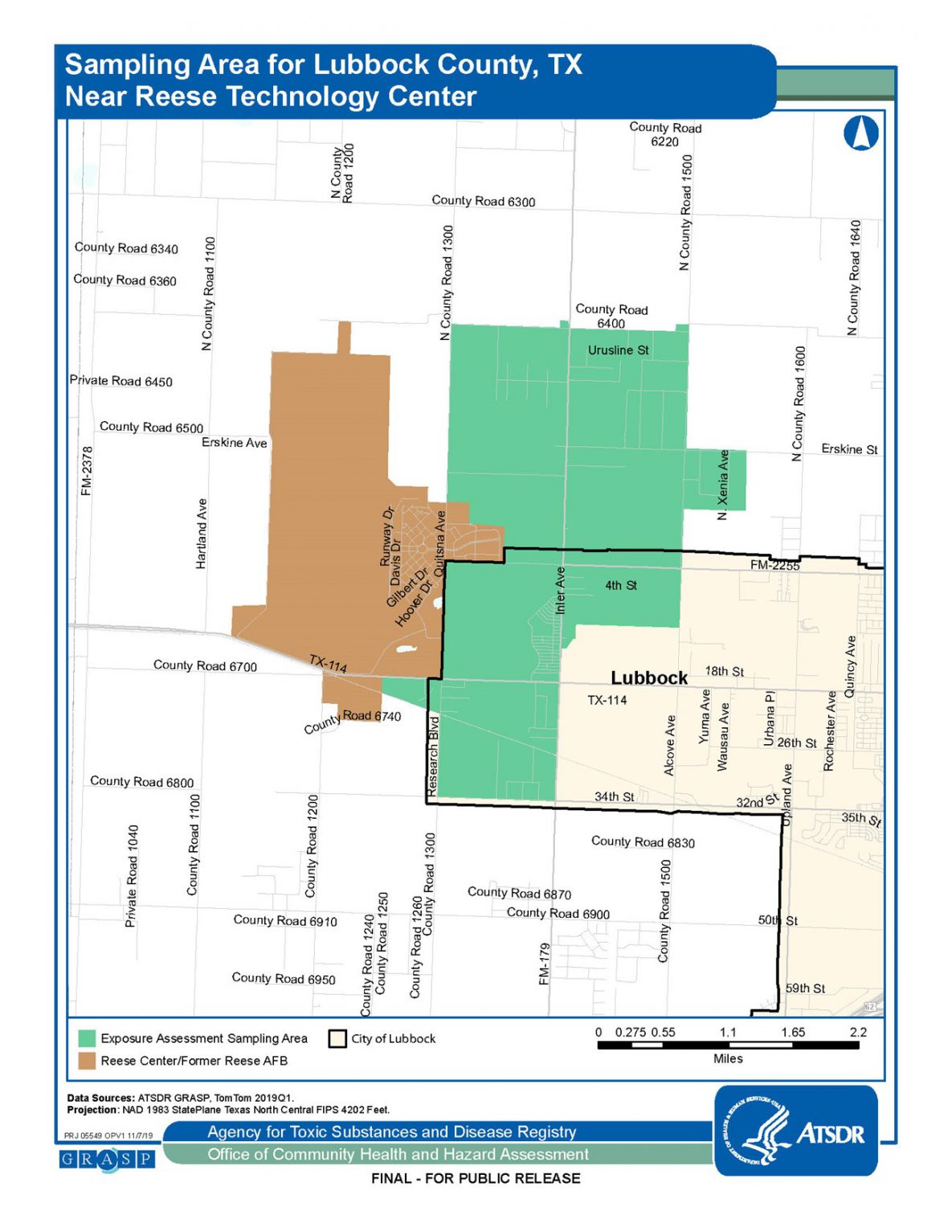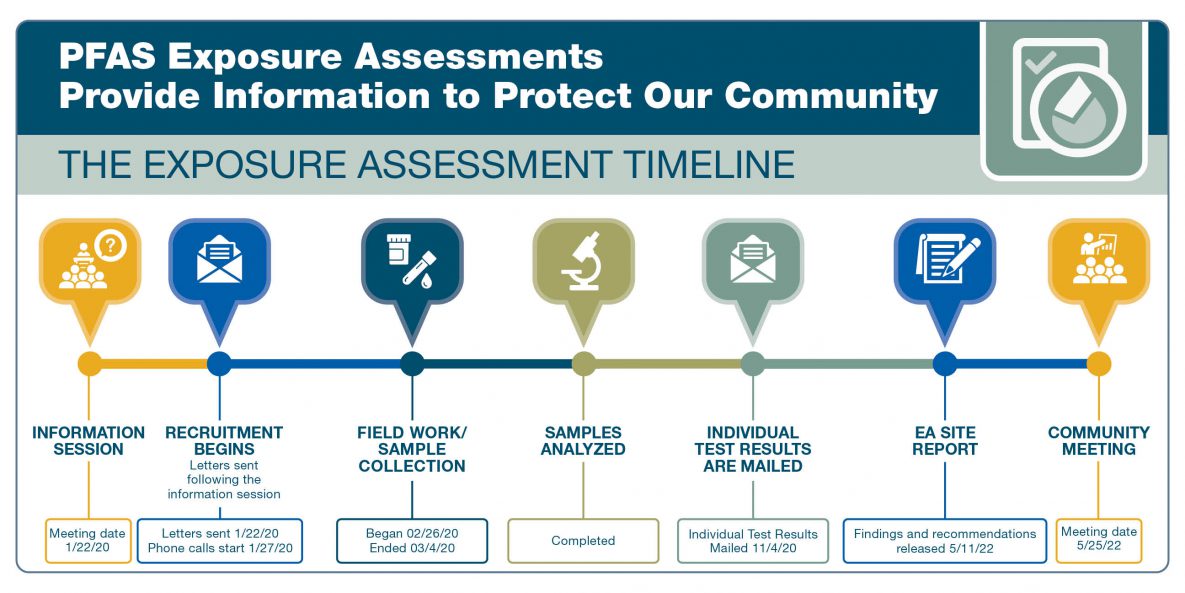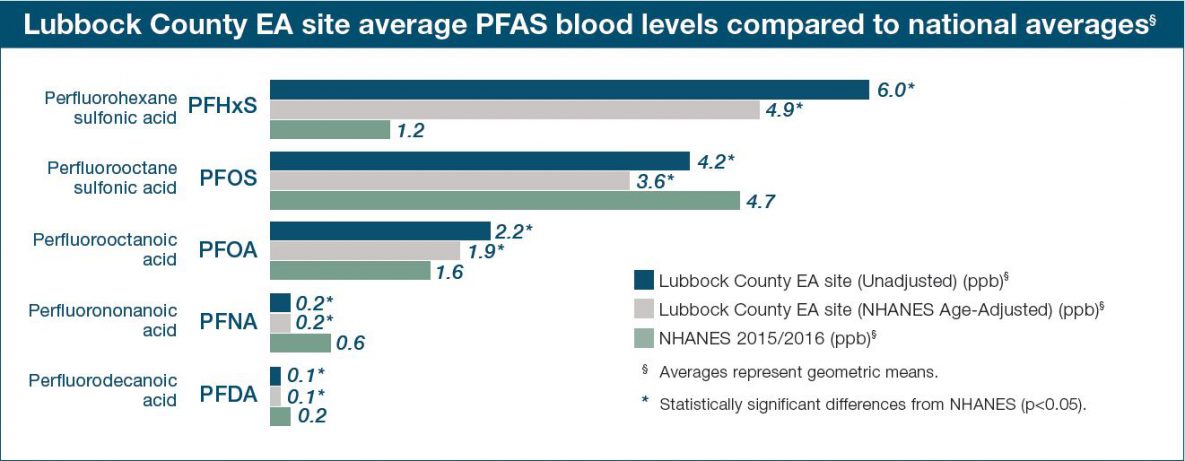Lubbock County (TX) near Reese Technology Center

Background
The Air Force used aqueous film forming foam (AFFF) at the former Reese Air Force Base (AFB), which led to PFAS within the foam seeping into the groundwater. The Air Force discontinued use of AFFF following base closure in 1997. The base has since been converted into a business and research park, the Reese Technology Center.
Why did we select the Lubbock County EA site?
When selecting EA sites, ATSDR considered the extent of PFOA and PFOS contamination in drinking water supplies, the duration over which exposure may have occurred, and the number of potentially affected residents. The Lubbock County EA site was one of several sites nationwide identified with PFAS drinking water contamination from use of products such as aqueous film forming foam (AFFF).
Possibly as early as the 1970s, the Base used AFFF containing PFAS for its firefighter training. Over time, the PFAS from the AFFF entered the ground, moved into the groundwater to offsite locations, and affected nearby private wells. PFAS were first detected in private wells downgradient of the Base in September 2017. To reduce levels of PFAS in drinking water, the Air Force installed whole-house treatment systems in affected homes and supplied bottled water.
Based on information available to ATSDR at the time of the EA, all households with private wells tested by the Air Force have a drinking water supply that meets, or is below, the U.S. Environmental Protection Agency’s (EPA) 2016 health advisory (HA) and state public health guidelines for PFAS in drinking water. Households that receive bottled water and/or have water filtration systems installed by the Air Force should continue to use these alternative sources of water.
How was the testing conducted?
ATSDR invited all Lubbock County residents living near the Reese Technology Center to participate in the PFAS exposure assessment. To be eligible to participate, household residents must have
- received their drinking water from a private well in the affected area in Lubbock County for at least 1 year before September 30, 2019 (these residents have the greatest likelihood of past exposures to PFAS via their private well’s drinking water),
- been older than three years old at the time of sample collection,
- not been anemic or have a bleeding disorder that would prevent giving a blood sample.
Residences served by the City of Lubbock Water Department were not included in the exposure assessment.
Results
In November 2020, CDC/ATSDR released a summary [PDF – 175 KB] of the biological and environmental test results. The full report was released May 11, 2022 and a summary of the report’s findings is presented below. The full report is available here [PDF – 2 MB].
ATSDR
analyzed data from
214
people
(190 adults and 24 children)
from
96
households
Everyone completed a questionnaire.
and most people provided
blood and urine samples.
ATSDR collected samples of tap
water and dust from some homes.
ATSDR sent each participant their individual results in November 2020.
Key Takeaways
- Levels of PFHxS and PFOA in the blood of Lubbock County EA participants were 4.2 and 1.2 times national levels, respectively. Other PFAS were not higher than the national levels or were detected too infrequently to compare to national averages.
- Elevated blood levels may be linked with past drinking water contamination.
- Some demographic and lifestyle characteristics were linked with higher PFAS blood levels.
- All tap water samples collected from Lubbock County private wells during the EA in 2020 met the EPA’s Health Advisory and Texas Commission on Environmental Quality’s (TCEQ’s) protective concentration levels (PCLs) for specific PFAS in drinking water.
The average blood levels of two PFAS (PFHxS and PFOA) in the Lubbock County EA participants were higher than the national average.
Of the seven PFAS tested at the Lubbock County EA site, five PFAS were detected in more than 77% of the blood samples collected: PFHxS, PFOS, PFOA, PFNA, and PFDA.
Since 1999, the National Health and Nutrition Examination Survey (NHANES) has measured PFAS levels in blood in the U.S. population. PFAS levels are shown to be age dependent and tend to increase with age in part due to longer periods of exposure. ATSDR adjusted blood levels of EA participants at the Lubbock County EA site for age to enable meaningful comparison to the NHANES dataset. After adjustment, the same two PFAS were still higher than levels nationwide, but slightly less so. Age-adjusted averages are more representative of the Lubbock County EA site community.
Blood levels of two PFAS in Lubbock County EA participants may be linked with past contamination of private well water.
Two PFAS (PFHxS and PFOA) were detected in Lubbock private wells as early as 2017. It is likely that contamination began earlier, but no data are available before 2017. Between 2017 and 2019, actions taken by the Air Force reduced PFAS levels in the drinking water of most private wells in the affected area below EPA health advisory for PFOS and PFOA and Texas Commission on Environmental Quality’s (TCEQ’s) protective concentration levels (PCLs) for multiple PFAS. There was 1 year and 4 months between the end of exposure via contaminated drinking water and the collection of the EA blood samples. Because of the long half-lives of PFHxS and PFOA in the human body, past drinking water exposures may have contributed to the EA participants’ blood levels. Typically, residents who had elevated blood levels of PFHxS also had elevated blood PFOA levels. This suggests a common source of exposure, such as contaminated groundwater that supplies drinking water to private wells in the area. Other sources of exposure were not measured but could have contributed to PFAS concentrations measured in blood of the EA participants.
Blood levels of PFHxS,
PFOS, and PFOA were
higher in older participants.
Males had higher blood
levels of PFOS and PFOA
than females.
| 70% higher for PFOS
The difference in PFOA levels was larger in younger people.
Residents who had carpeting
in any room had higher PFHxS
and PFOA levels.
Residents who reported coming in contact with soil a few times per month or more had higher PFHxS blood levels.
Women who have given birth
had lower PFHxS levels than
women who had not.
Women who breastfed had
lower blood levels of PFOS
by 27% than women who did
not breastfeed.
Fact sheets and Report
- PFAS Exposure Assessment, Lubbock County, TX: Report [PDF – 2 MB] (4/11/2022)
- PFAS Exposure Assessment, Lubbock County, TX: Report Appendix [PDF – 2 MB] (4/11/2022)
- PFAS Exposure Assessment, Lubbock County, TX: Report Consumer Summary [PDF – 297 KB] (4/11/2022)
- PFAS Exposure Assessment, Lubbock County, TX: Fact Sheet [PDF – 373 KB]
- PFAS Exposure Assessment, Lubbock County, TX: Community-Level Summary Results Fact Sheet [PDF – 175 KB]
CDC and ATSDR invite all residents of the Lubbock County to attend a virtual information session to learn more about the results of the PFAS exposure assessment. Experts will also answer community questions.
When
May 25, 2022
Time
6:00 p.m. CT
To register, go to: https://bit.ly/LubbockEAMtg
ATSDR staff will also host small, in-person and online meetings to answer questions.
ATSDR staff are available in-person at the Reese Technology Center (9801 North Reese Boulevard, Suite #200, Building 800 – 2nd Floor Board Room, Lubbock, TX 79416) on May 26th from 10am – 12pm; 2pm – 4pm; and 6pm – 8pm, and on May 27th from 8am – 10am to answer community questions.
Staff are offering an additional virtual meeting on June 2nd from 12pm – 1pm.
Those interested in participating in the small, in-person and online meetings are encouraged to sign up here: https://bit.ly/LubbockSmallMtg.


